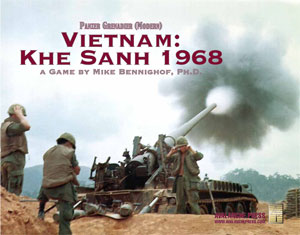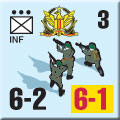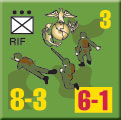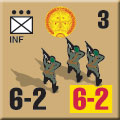| Vietnam: Khe Sanh 1968
Publisher’s Preview
By Mike Bennighof, Ph.D.
February 2021
 In December 1967, the People’s Army of Vietnam (PAVN, often called the North Vietnamese Army, or NVA, by the Americans) issued orders to isolate the American hilltop outpost known as the Khe Sanh Combat Base. What they intended beyond that is unclear more than 50 years later, as afterwards both sides would adjust their intentions to meet their results and declare victory. In December 1967, the People’s Army of Vietnam (PAVN, often called the North Vietnamese Army, or NVA, by the Americans) issued orders to isolate the American hilltop outpost known as the Khe Sanh Combat Base. What they intended beyond that is unclear more than 50 years later, as afterwards both sides would adjust their intentions to meet their results and declare victory.
What is perfectly clear is that the next six months saw intense fighting in Quang Tri Province, the northernmost province of South Vietnam, including the Tet Offensive. The base itself was held by two regiments of U.S. Marines, with the help of some South Vietnamese (Army of the Republic of Vietnam, or ARVN) troops. U.S. Army and Royal Laotian units also saw action in the campaign, though they were not part of the garrison itself.
If the North Vietnamese weren’t trying to capture the Khe Sanh Combat Base, they certainly faked it very well, pressing the Marines so hard that the American military leadership seriously discussed using tactical nuclear weapons to defend the base. The PAVN did succeed in cutting off the Marines, but Army troops broke through to relieve the siege and by summer the American command had decided to abandon and destroy Khe Sanh. Both sides would declare victory, but the actual result appears indecisive.
 Vietnam: Khe Sanh 1968 is our Panzer Grenadier (Modern) treatment of the campaign. It’s a standard-sized game out of the Panzer Grenadier family, with 517 die-cut and silky-smooth pieces, four geomorphic maps (that fit with maps from Panzer Grenadier and Infantry Attacks as well as other games in the Modern series) and 40 scenarios. Vietnam: Khe Sanh 1968 is our Panzer Grenadier (Modern) treatment of the campaign. It’s a standard-sized game out of the Panzer Grenadier family, with 517 die-cut and silky-smooth pieces, four geomorphic maps (that fit with maps from Panzer Grenadier and Infantry Attacks as well as other games in the Modern series) and 40 scenarios.
Like Panzer Grenadier, Panzer Grenadier (Modern) was intended from the start to model all forms of tactical combat, in this case from the 1960’s and 1970’s. The other two games in the series are built around large-scale tank combat: 1967: Sword of Israel in the Six-Day War, with masses of tanks churning up the dust of Sinai, the West Bank and the Golan Heights, and Cold War: Fulda Gap 1968 sending waves of Soviet, American and West German tanks across the central German countryside in a war that everyone expected but no one actually fought.
Khe Sanh 1968 is completely different than either of those games. To begin with, the scenarios are almost always smaller than the armor-heavy battles, with just one or two maps in play and maybe a couple dozen units per side. Neither side is usually very interested in capturing and holding geographic objectives; everyone knows that the U.S. Air Force will turn any hilltop or village into very finely ground powder if the PAVN tries to hold out there very long. The battles are instead brutal, close-range infantry firefights and over in a short time.
 At least the battles outside the main base’s perimeter. The PAVN also made multiple serious attempts to take the Khe Sanh base itself by storm, resulting in some intense fighting at and inside the perimeter. All of those attempts failed, but the PAVN did overrun the smaller Special Forces camp at Lang Vei. At least the battles outside the main base’s perimeter. The PAVN also made multiple serious attempts to take the Khe Sanh base itself by storm, resulting in some intense fighting at and inside the perimeter. All of those attempts failed, but the PAVN did overrun the smaller Special Forces camp at Lang Vei.
Direct assaults on the Americans, or even the South Vietnamese, were always long-shot rolls of the dice (the Laotians were a different story). The Americans wield overwhelming firepower. The Marine platoons are loaded with automatic weapons; the PAVN is pretty well-armed too, though not quite so powerful, and actually has a slightly better anti-tank weapon (not that either side is going to be reaching for those very often). Once you get past the infantry platoons, it’s no longer close. The Americans have artillery and more artillery; that was the whole purpose of the Khe Sanh Combat Base with 46 artillery pieces of its own plus the supporting fire of the huge 175mm guns at Camp Carroll. American tubes would fire over 150,000 rounds during the siege.
And the Americans have air power, all sorts of air power ranging from the mighty B52 BUFFs on down to helicopter gunships. The U.S. Air Force dropped more than five tons of bombs for every PAVN soldier involved in the battle and turned most of the surrounding jungle into finely-chopped mulch. The U.S. Army’s First Air Cavalry Division spearheaded the relief of Khe Sanh, and so the Americans get to undertake airmobile operations, too.
 The PAVN does have batteries of long-range Soviet-made M46 130mm guns located safely in Laos; they don’t out-range the 175mm M107 but the American gun couldn’t hit anything at that range which leaves them able to rain down fire on Khe Sanh with some impunity. Otherwise, the North Vietnamese are going to have to rely on guile to out-maneuver the Americans, which is pretty tough when the Americans have helicopters to go with all that firepower. But the Vietnamese are determined, with good initiative and morale even in trying circumstances. The PAVN does have batteries of long-range Soviet-made M46 130mm guns located safely in Laos; they don’t out-range the 175mm M107 but the American gun couldn’t hit anything at that range which leaves them able to rain down fire on Khe Sanh with some impunity. Otherwise, the North Vietnamese are going to have to rely on guile to out-maneuver the Americans, which is pretty tough when the Americans have helicopters to go with all that firepower. But the Vietnamese are determined, with good initiative and morale even in trying circumstances.
The Marines have a handful of M48 tanks in Khe Sanh which mostly served for armored fire-support. The PAVN brought its 198th Tank Battalion with a handful of PT-76 amphibious light tanks, which did not impress the Marines or the American Special Forces but did terrify the Royal Laotian troops.
Five decades later, the Marines still insist that there was no siege of Khe Sanh, as the base was never completely isolated. The operations to “relieve” the base, in this telling, were an exercise in public relations more than a military necessity - though they most certainly involved real combat, costing the lives of close to a hundred Americans and thousands of PAVN troops.
While we named the game Khe Sanh 1968, it covers much more than the siege or not-siege of the combat base, but rather many different actions that took place in Quang Tri Province in 1968; “Quang Tri 1968” might be more accurate, but it’s a much less evocative title. The U.S. Marines see plenty of action, but there’s a great deal of fighting waged by the air cavalry and special forces, and the ARVN contingent.
In the short, sharp actions that characterized the war in Quang Tri Province, the PAVN can hold its own with the Americans. The American forces, whatever the branch, can vary in quality but are still usually very good; this would decline markedly after 1968 and the Tet Offensive. Vietnamization - the replacement of American units with ARVN troops - would begin a month after the Khe Sanh base was abandoned, and short-timer syndrome would rapidly spread through the American forces in Vietnam. But that’s another story for another game.
Don’t wait to put Vietnam: Khe Sanh 1968 on your game table! Join the Gold Club and find out how to get it before anyone else, at a better price than anyone else!
Sign up for our newsletter right here. Your info will never be sold or transferred; we'll just use it to update you on new games and new offers.
Mike Bennighof is president of Avalanche Press and holds a doctorate in history from Emory University. A Fulbright Scholar and NASA Journalist in Space finalist, he has published way too many books, games and articles on historical subjects. A few of them did not suck.
He lives in Birmingham, Alabama with his wife, three children and his dog, Leopold. Leopold has his own office chair.
|
